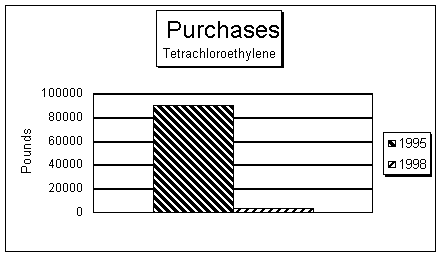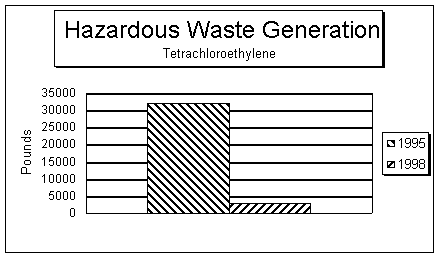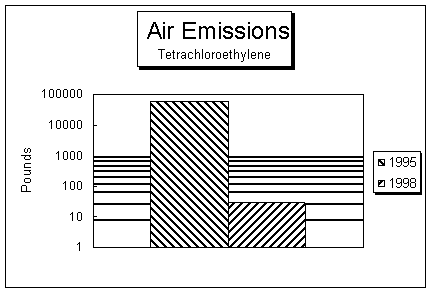Parts Degreasing
Connecticut Spring and Stamping Corporation
A Pollution Prevention Case Study
Overview
Between 1995 and 1998, the Connecticut Spring and Stamping Corporation of Farmington reduced its purchase of Tetrachloroethylene (perc) by over 98%, perc hazardous waste generation by over 95% and perc air emissions by over 99%. The company has changed its hazardous waste generator status from Large Quantity Generator (LQG) to Small Quantity Generator (SQG). This has dramatically reduced their associated management costs and regulatory burdens. These changes were made as a result of both company initiative and DEP regulatory involvement. This win-win situation has resulted in benefits to the state from a cleaner environment, to the company from improved profitability and to the workers from a healthier workplace. The company is now well positioned to win new business and reports that the new cleaning process is very reassuring to present customers.
Background
Connecticut Spring and Stamping is a privately owned corporation that has been in business since 1940 and at the present site since the 1960's. The plant encompasses about 130,000 square feet and currently employs about 450 workers. It operates approximately 20 hours per day, six days per week.
The company makes a variety of spring products from both wire and sheet metal. After the winding, bending, stamping and grinding operations, some products must be cleaned before a final finish is applied. Since the 1960's, the company has used two open-top (10 square feet opening) vapor degreasers utilizing perc as the working fluid to remove lubricants and other contaminants. By 1994, several factors combined to encourage the company to search for alternatives to the traditional vapor degreasers:
-
The design of the old equipment led to the purchase of large quantities of virgin perc at significant expense.
-
As a result of the Federal Clean Air Act Amendments (CAA) of 1990, the requirements for vapor degreasers were tightened to reduce emissions. These regulations are called the Maximum Achievable Control Technology (MACT) standards. This facility is also subject to the Title V air permitting requirements.
-
In the 1970's a spill of waste perc and leaks from a sump resulted in contamination of the property with the attendant long term liability.
-
Waste perc is regulated as a hazardous waste under the Federal Resource Conservation and Recovery Act (RCRA). As such, it is very expensive both to manage and to dispose, and it creates a long-term liability for the generator.
-
Perc is a known human health hazard, so worker exposures must be limited. To limit exposures meant reducing emissions or installing a venting system.
Alternatives Sought
In order to reduce expenses, the company purchased two replacement vapor degreasers in 1996 (one 18 ft2 and one 8 ft2 - both circa late 1980's open top design). This cut their purchases of virgin perc by about 50% and their emissions of perc vapors by about 70%, but did not change their waste perc generation appreciably. Still faced with not being able to meet the tightening CAA regulations for air emissions from vapor degreasers, the company investigated their requirements for parts cleaning. They took parts to a variety of vendors of vapor degreasers and aqueous cleaning systems. Through these trials, they found that approximately 90% of the parts could be cleaned with an aqueous process, but the remaining 10% required the solvent cleaning process to meet customer requirements. This meant that they could reduce their perc expenses but at the added expense of starting another cleaning process with additional waste streams. It would also mean training workers to segregate parts according to the required cleaning process and to operate both processes. The capital outlay would be higher and the floor space requirements would be more than doubled. Since the vapor degreasing process could not be eliminated completely, the company decided to keep it for all parts cleaning and to purchase two new open-top dip tanks with programmable controls. This system would allow them to remain in compliance with all current environmental regulations.
As part of resolving assessed penalties for unrelated violations (identified during a routine DEP inspection in 1997) the company elected to make even greater investments in upgrading their degreasers. The improved technology of the more expensive equipment was projected to reduce both perc hazardous waste generation and air emissions by over 90%.
New System Purchased
The company purchased a turn key system which was installed in October, 1997. It consists of two Pero Model 2501A batch-mode closed-loop vapor degreasers with an in-line still to recover valuable perc in the waste from the two units. It also has a closed-loop cooling system with a chiller unit, which eliminated a wastewater discharge. The actual perc reductions achieved as a result of these changes are shown in the following three figures and on the table included on the last page of this document.


 The company experienced some problems when it changed over to the new system. The pH went out of spec in the first month, and they had to drain and cleanse the units. The vendor helped out with the process and changed procedures to ensure that this does not occur in any new installations. The company has since outsourced the functions of chemistry checking and adjustment to a local perc supplier, and this has worked well for them.
The company experienced some problems when it changed over to the new system. The pH went out of spec in the first month, and they had to drain and cleanse the units. The vendor helped out with the process and changed procedures to ensure that this does not occur in any new installations. The company has since outsourced the functions of chemistry checking and adjustment to a local perc supplier, and this has worked well for them.
There was about a three-month period of adjustment for the employees, mostly due to the increased maintenance requirements of these machines. Unlike the traditional open- top systems, these are state-of-the-art systems with specific operating and maintenance requirements. When operated and maintained correctly, they produce more consistent higher quality results with dramatically reduced perc wastes and emissions.
Improved Generator Status
The company's environmental manager reports that they have changed their generator status from Large Quantity Generator (LQG) to Small Quantity Generator (SQG), with the attendant reduction in overhead and regulatory requirements. They could qualify as a Conditionally Exempt Small Quantity Generator (CESQG) except that they may have an occasional month when they may bump up to SQG, so administratively it was easier to remain a SQG.
The company has been keeping very close track of the amount of perc purchased, shipped off site as hazardous waste and emitted. With this close tracking, they have determined that they are emitting approximately 20% of the EPA standard for vapor degreasers. Through a material balance, they calculate that they emit 17 Kg per machine per shift per month. The EPA standard is 83 Kg per machine per shift per month. The employees are pleased with the new system due to dramatically reduced odors (which also eliminated the need for personal protective equipment or an exhaust system).
Their customers are happy with the new system, as it is seen as a more environmentally friendly process. The company also reports that there seem to be some labor savings with the new system in place, but these have yet to be quantified.
Pollution Prevention works!
Tetrachloroethylene Amounts and Associated Costs
|
1995 |
1998 |
Savings / Year | |
|---|---|---|---|
| Tetrachloroethylene Purchases | 89,760 lb. @ $ 0.43 / lb. (6,600 Gallons 3 ) |
2,992 lb. 2 @ $ 0.52 / lb. (220 Gallons 3 ) |
$37,040 |
| Tetrachloroethylene Hazardous waste generated | 43 drums @ $ 190 / drum (= 32,164 lb. 1= 2,365 Gallons 3) |
4 drums 2 @ $ 190 / drum (= 2,992 lb. = 220 Gallons 3) (30% perc, 70% oils & dirts 4) |
$7,410 |
| Tetrachloroethylene Air emissions | 57,596 Pounds 1 |
30 Pounds 4 |
Not calculated |
| Wastewater processed by evaporator | 300,000 Gallons 5 | Eliminated | Not calculated |
1. Source: EPA Biennial Reporting System
2. Estimated by extrapolating year to date amounts
3. Density of Tetrachloroethylene is 13.6 lb. / gallon
4. A waste analysis is performed to determine the actual content of the waste. This also allows the perc emissions to be calculated via a material balance. This figure may go up if groundwater remediation activities commence using air stripping techniques.
5. Based on company data.
The information in this case study is provided solely as a service to Connecticut businesses. This information may not include all available services and suppliers, and does not constitute an endorsement by the DEP or The Connecticut Spring and Stamping Corporation. Use of this information does not in any way lessen your responsibilities for compliance with applicable state and federal laws.
Prepared by the Connecticut Department of Environmental Protection. For more information, call the Office of Pollution Prevention at (860) 424-3297, or Chuck Thomas of The Connecticut Spring & Stamping at (860) 677-1341.
Content Last Updated on December 12, 2006

